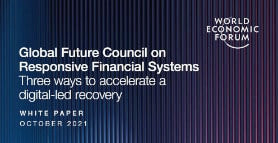A new World Economic Forum white paper finds reason to believe that digital ID programs will be decisive in modernized financial services.
In turn, those digitized services will play a growing role in a global economic recovery from the COVID pandemic.
Three factors are cited as recovery accelerators.
First, digital ID will be the “catalyst” of a more fully digital future. Second, small and mid-sized businesses the world over — heavily impacted by COVID — will be helped back to health thanks to digital identification programs.
Third, and more measurable than the first two, is evidence out of China that digital services, including IDs and biometric systems have “transformed consumer habits and delivered tangible benefits” to Chinese citizens.
The first accelerator, digital ID, will give people everywhere access not only to financial services but to political and social circles. India’s Aadhaar identification program is cited as one example.
Paul Romer, the World Bank’s chief economist, is referenced in the paper, saying despite drawbacks encountered, Aadhaar gives millions high-speed access for the first time have to business and government services.
Follow-on ripples from digital identification programs, including in banking, payment and informed regulation are examined as well.
Officials of some developing economies — China, Ghana, India among others — are sold on the idea. Nigeria has been pushing its digital ID program, and has reported that 66 million or more citizens and legal residents have enrolled their biometric identifiers to get a national ID.
The second accelerator, a revived small and mid-sized business sector, depends on digital IDs making access to financing far easier and more commonplace. This is as true in developed economies, where sole-proprietors might service electronics, as it is in developing economies, where small businesses might address more basic — but just as important — economic needs.
Of course, those businesses can also use digital services to become more a part of buyers’ economic lives.
The third accelerator is experience gained in China. For example, appetites for digital financial management services increased by 10 percent since COVID struck.
Pre-pandemic digital growth, of course, often was more robust, but points to how digital IDs can boost an economy.
The size of China’s digital wealth-management market was 772.6 billion yuan (US$120 billion) in 2013 and 6.9 trillion yuan ($1 trillion) by 2019. According to the paper, the market accounted for 13.2 percent of China’s asset-management activity.
In 2019, 170 million Chinese Internet users bought internet financial products. The annual growth rate of citizens buying financial products online was more than 10 percent that year, a point the market had held for some time.
Article: WEF cites stats showing how digital IDs can accelerate national economies
